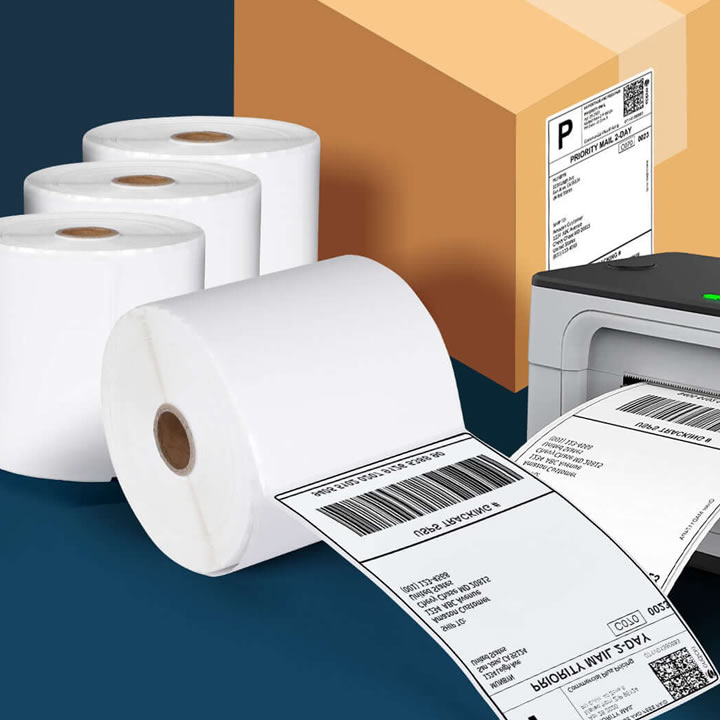Is it your first hearing about StarTrack labels? In simple words, StarTrack labels are another way of saying dispatch labels. These labels are specifically developed for use in direct thermal printers for barcode and dispatch labels.
Thanks to StarTrack, delivering packages quickly and conveniently throughout Australia’s capital cities is possible. But there is more you need to know before printing labels and dispatching packages with StarTrack!
Let’s discuss the prerequisites and other significant elements for premium StarTrack thermal shipment labels.
1. Printing Methods
Your printing method is an important part of your StartTrack shipping labels. The use of incorrect printing methods can throw the whole logistics off course. Here, one thing that decides the suitable printing method for your shipment is the time you need your labels to last.
For example, labels printed in a direct thermal label printer are water and scratch resistant, appropriate for the majority of shipping applications, and often scannable for up to six months.
However, you might want to consider employing the thermal transfer printing technique if your shipments are exposed to UV light, dampness, or extremely high or low temperatures.
This method ensures a tougher finish as it melts the label stock with substrate from a wax or resin ribbon.
The method you choose will also decide the kind of label stock you should purchase. So, the first and most important thing to understand before getting started is your requirements.
2. Label Size
The next element that you should consider is the label size. The usual label size preferred by almost all Australian couriers is 100x150mm, and these labels are mostly compatible with the My StarTrack software.
However, when you are printing in high volume, look for 350-label rolls or more to minimize changeovers. You can also employ roll or fanfold labels with this size. Then, there is a 100x150mm label size, which may be printed with various desktop and commercial label printers.
Again, needless to say, look for your specific requirements and make a decision.
3. Label Adhesive
Label adhesive is crucial in a shipment. A low-performing adhesive can slip off the label, which can be trouble.
So, you must go for the right label adhesive.
Some 100x150mm regular direct thermal labels have a premium permanent adhesive that attaches quickly to cardboard boxes and cartons, guaranteeing that your labels will remain firmly in place as the shipment travels to its destination.
But if you need labels for StarTrack delivery that meet a certain specification, you can also go for labels with cold-temperature adhesive or other specific features you want.
4. Label Tracking
One of the prime features of StarTrack labels is the ability to track the shipment. Just by using the tracking ID on the label, you will know the status of your package. Because of this important feature, labeling has even more prominence with StarTrack deliveries.
Without the label, it is impossible to track the package. So, you should ensure that the labeling is right beforehand.
5. My StarTrack Software
StarTrack has an official online software called My StarTrack that allows users to create consignments, print labels, and schedule pick-ups.
Therefore, it is essential that the StarTrack labels you are using are compatible with My StarTrack software. The labels must be made to the software’s specific guidelines to ensure My StarTrack barcoding format fits perfectly for every print.
6. Use High-Quality Labels
You must never compromise the quality of the label material. Because if the label is of poor quality, it might not stay on the package until reaching the destination.
To solve this problem, most businesses tape the label to the package. However, there are better solutions than this, as even transparent tape can sometimes interfere with legibility and scanning.
So, it is recommendable to use high-quality labels in the first place to avoid such issues during transit. If so, you do not have to trouble yourself with covering the label with tape, as it can only decrease productivity.
7. Ensure a Spare Label
One very common problem with logistics is label damage in transit. When that happens, things get difficult as there will not be any information or possibility of tracking. So, to avoid trouble, businesses often place an additional shipment label inside the package.
If the label on the package gets damaged, the one inside will be helpful. For this, you need to print more labels than necessary. So, be sure to consider this precaution while purchasing the label material (for in-house printing) or outsourcing the print job.
Even If there is a remote chance that there will be damage during transit, think about inserting an additional shipping label inside the container.
Bonus Tips For Effective StarTrack Labelling
Apart from the above Seven features, here are a few more tips for ensuring successful StartTrack labeling.
- To save changeover time, select high-volume label rolls or fanfold choices.
- To prevent confusion, use only one clear label per carton or box and cover up any unnecessary labeling.
- You can also talk to a provider for more information on branding your labels well and effectively.
Conclusion
There you go! Now you know the most important things you should consider while looking for StarTrack labeling. We hope this quick guide helped you understand more about StarTrack labels.
But if you still have more questions about these dispatch labels, you can also get in touch with a provider of StarTrack labels, and they will be able to help you. And the DAL is a good place to start!

